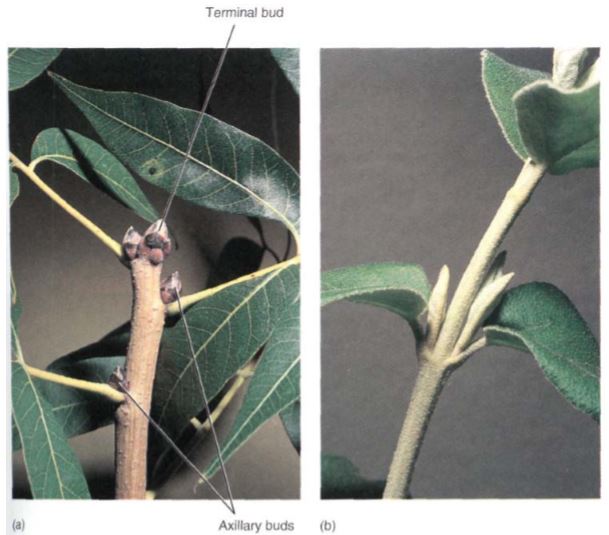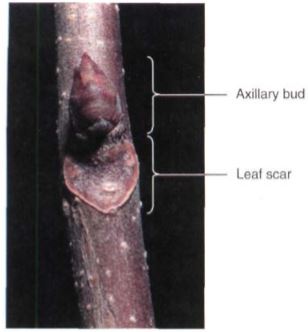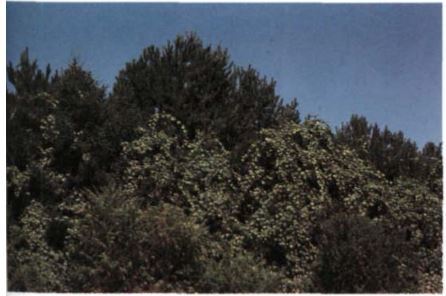External Organization of Stems
The terms "stem" and "shoot" are sometimes used interchangeably, but technically the stem is an axis, whereas the shoot is the stem plus any leaves, flowers, or buds that may be present. All flowering plants have the same basic stem organization: There are nodes where leaves are attached, and internodes, the regions between nodes. The stem area just above the point where the leaf attaches is the leaf axil. Within it is an axillary bud, a miniature shoot with a dormant apical meristem and several young leaves fig.1 ); it is either a vegetative bud if it will grow into a branch, or a floral bud if it will grow into a flower or group of flowers. The bud is covered by small, corky, waxy bud scales (modified leaves) that protect the delicate organs inside. At the extreme tip of each stem is a terminal bud. In winter, when all leaves have abscised, leaf scars occur where leaves were attached (Fig. 2).

FIGURE 1: (a) In these buds of pistachio, the leaves are modified into bud scales, just as prickly leaves of prickly pear buds are modified into spines. The bud scales are waterproof and protective, but they are shed when the bud begins to grow in the spring and produces photosynthetic leaves. Notice that there are buds in the axils of the leaves and a bud at the very tip of the shoot. (b) The two axillary buds of this Viburnum have already begun to grow into branches, and their first young, expanding leaves are visible. These buds were formed in the spring and started growing immediately; they did not form dormant buds with bud scales.
it is either a vegetative bud if it will grow into a branch, or a floral bud if it will grow into a flower or group of flowers. The bud is covered by small, corky, waxy bud scales (modified leaves) that protect the delicate organs inside. At the extreme tip of each stem is a terminal bud. In winter, when all leaves have abscised, leaf scars occur where leaves were attached (Fig. 2).
The arrangement of leaves on the stem, called phyllotaxy, is important in positioning leaves so that they do not shade each other (Fig. 3). If only one leaf is present at each node, the stem has alternate phyllotaxy (the leaves alternate up the stem); two leaves per node is opposite phyllotaxy, and three or more per node is whorled phyllotaxy. The orientation of leaves at one node with respect to those at neighboring nodes is also important. In distichous phyllotaxy, the leaves are arranged in only two (di-) rows (-stichies), as in corn and irises. The leaves may be alternate or opposite. In decussate phyllotaxy, the leaves are arranged in four rows; this occurs in only some of the species with opposite leaves. Finally, in spiral phyllotaxy, each leaf is located slightly to the side of the ones immediately above and below it, and the leaves form a spiral up the stem. This is the most common arrangement and may involve alternate, opposite, or whorled leaves (Table ). Different types of phyllotaxy are selectively advantageous, depending on leaf size and shape.

FIGURE 2: As a leaf falls from a stem, it tears cells and creates a wound; a leaf scar is a layer of cork that seals the wound, keeping fungi and bacteria out and preventing water loss.
All flowering plant shoots are based on this simple arrangement of nodes and internodes, and diversity and specialization are variations of this arrangement; in vines internodes are especially long, whereas in lettuce, cabbage, and onions, internodes are so short that leaves are packed together (Fig. 4). Internodes can be wide (asparagus), intermediate, or narrow (alfalfa sprouts). The diversity is not random—the different types provide particular adaptive advantages in certain situations. For example, plants are physically bound to the site where they happen to germinate, which by accident may be a shady area near a more optimal sunny spot. Vines, with their elongated internodes, are a means by which a plant can "explore" its immediate surroundings, and shoots that happen to grow into a sunnier site may flourish (Fig.5). In some species of climbing vines, support and attachment are provided by tendrils—modifed leaves or lateral branches capable of twining around small objects.


FIGURE 3 Phyllotaxy. (a) The leaves of this Erythroxylon coca (coca, source of cocaine) are arranged with alternate phyllotaxy—one leaf per node occurring in all directions around the stem. (b) The leaves of this melostome show opposite phyllotaxy—two leaves per node, each pair pointing 90 degrees away from the previous and subsequent pairs. (c) Whorled phyllotaxy in Fuschia: There are more than two leaves per node. The axillary buds are obviously floral buds.

FIGURE 4: The nodes of cabbage are packed closely together, and all leaves are tightly clustered. Such closely packed, large leaves with spiral phyllotaxy are poor at photosynthesis and did not evolve by natural selection; they were produced by plant geneticists.
The capacity to explore is even more advanced in stolons, also called runners (Fig. 6) . Because their internodes are especially long and thin and their leaves do not expand, stolons extend greatly without using much of the plant's nutrient reserves. Once the stolon encounters a suitable microhabitat, subsequent growth is by shorter, vertical internodes and fully expanded leaves; new roots are established and the end of the stolon resembles a new plant.

FIGURE 5: These grape vines (Vitis) are able to place their leaves in the full sun at the top of the forest canopy, even though they have not invested much sugar in building strong trunks. The pines that support these vines may ultimately die because they are so heavily shaded by the grape leaves.

FIGURE 6: These grape vines (Vitis) are able to place their leaves in the full sun at the top of the forest canopy, even though they have not invested much sugar in building strong trunks. The pines that support these vines may ultimately die because they are so heavily shaded by the grape leaves.
If older parts of the plant die, these vertical shoots become independent plants. After they have started growing vigorously, these plants send out stolons of their own.
In some shoots, nutrient storage is particularly important for survival; these shoots are often massive and quite fleshy, thus providing room for accumulating starch. The form of the shoot depends on whether starch accumulates in leaves or stems. Bulbs are short shoots that have thick, fleshy leaves (onions, daffodils, garlic), whereas corms are vertical, thick stems that have thin, papery leaves (crocus, gladiolus; Fig. 7). There is no obvious selective advantage of one over the other; the type seems to depend on whether mutations affecting the stem or leaf happen to occur first. Rhizomes are fleshy horizontal stems that allow a plant to spread underground (bamboo, irises, canna lilies).

FIGURE 7: (a) Onions are bulbs: They have short vertical stems and fleshy leaves. (b) Gladioluses have corms with fleshy stems and papery leaves. (c) A tuber (potato: Solatium tuberosum) is a short horizontal stem that grows only for a limited period of time. Its leaves are microscopic, and its axillary buds are the potato's "eyes," shown here by light microscopy (X 15).
Tubers are horizontal like rhizomes, but they grow for only a short period and are mainly a means of storing nutrients (potatoes).
All these storage shoots are subterranean, which is more advantageous for storage than an exposed surface location. A plant needs storage capacity only if it is perennial and goes through a dormant period. Quiescence is the means by which perennial plants of harsh climates survive the stress of winter cold or summer heat and dryness; they often shed their leaves, reducing water loss. In order to produce new twigs, leaves, and roots in the favorable season, they must draw on stored carbohydrates. Protection of their nutrient reserves -the corms, bulbs, rhizomes, and tubers-is most easily accomplished by burying them at depths that do not freeze or dry out. Their subterranean location also hides them from most herbivores.

FIGURE 8: Division of labor: False Solomon's seal (Smilacena racemosa) consists of subterranean rhizomes (which survive harsh winters and spread through the soil) and aerial shoots (which carry out photosynthesis and flowering).
Each of these specialized tasks is accomplished by characteristic modifications in stem structure and metabolism. As with multicellularity, specialization is accompanied by division of labor: Modifications that increase a stem's ability to survive, spread, or store nutrients decrease its efficiency at other tasks. No plant consists only of rhizomes, which are not exposed to light, because most plants must photosynthesize. Therefore, at least some of the rhizome's axillary buds must grow upward above ground and have green leaves (Fig. 8). Similarly, a plant cannot be made up only of stolons: Modifications that allow quick, low-cost exploration are not appropriate for growth, photosynthesis, and sexual reproduction (flowering). It is common for individual plants to have several types of stems and leaves, each of which contributes uniquely to the plant's survival.
Although the axil of every leaf contains a bud, only a few buds ever produce a branch; the others remain dormant or produce flowers. Axillary buds do not become active at random; each species has a particular pattern. In shady environments, it may be advantageous for axillary buds to remain dormant so that all resources are concentrated in the growth of the vertical main shoot, the trunk, allowing the plant to reach brighter light in the top of the forest canopy (Fig. 9).

FIGURE 9: (a) In a heavily shaded forest, suppression of branching allows all resources to be concentrated on placing one shoot up into the light. (b) With abundant light, one main trunk is not so advantageous; instead, a high degree of branching allows the rapid production of many leaves.
In an open environment, such dominant upward growth is not particularly advantageous; it may be better for all buds to grow and thereby maximize the rate at which new leaves are formed. On almost all plants, at least a few axillary buds remain dormant and serve as reserve growth centers. As long as the apical meristem is healthy and growing well, some axillary buds are unneeded; if the apical meristem is killed by frost, insects, or pruning, axillary buds become active and replace it, allowing the growth of the shoot to continue.
 الاكثر قراءة في مواضيع عامة في علم النبات
الاكثر قراءة في مواضيع عامة في علم النبات
 اخر الاخبار
اخر الاخبار
اخبار العتبة العباسية المقدسة


